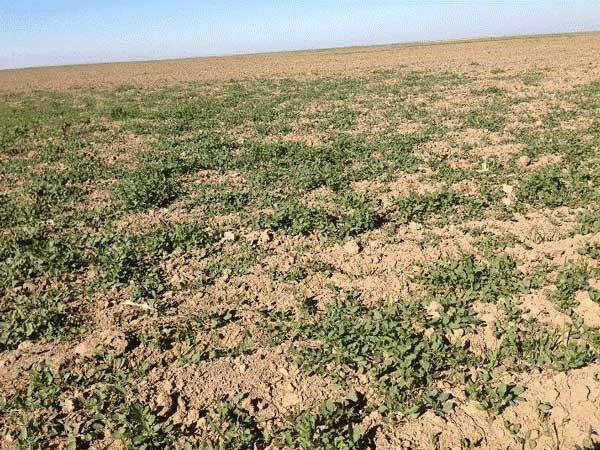Field bindweed is a deep-rooted perennial weed that severely reduces crop yields and land value. This noxious weed infests just under 2 million acres and is found in every county in Kansas. Bindweed is notoriously difficult to control due to its ability to store large amounts of energy in roots. Field bindweed produces over 2 tons of roots per acre! Because of this large energy reserve, field bindweed is especially difficult to control with a single herbicide application. During the fall, but prior to a killing freeze, can be an excellent time to treat field bindweed because it is moving carbohydrate deep into its root system during this period, which can assist the movement of herbicide into the root system.

Figure 1. Field bindweed ready for a fall treatment. Photo by Curtis Thompson, K-State Research and Extension.
The most effective control program includes preventive measures over several years in conjunction with persistent and timely herbicide applications. The use of narrow row spacings and vigorous, competitive crops such as winter wheat or forage sorghum may aid control. No-till has been very beneficial for managing bindweed by providing routine herbicide treatments through time and not breaking up the root system and dragging root segments around the fields. No-tillage maintains much of the bindweed seed soil bank at a depth too deep to germinate, so it is common to see a resurgence of bindweed after tilling fields that have been in long-term no-till.
Herbicides in Group 4, such as dicamba, Tordon, 2,4-D ester, and Facet L, as well as glyphosate applied alone or in various combinations are registered for suppression or control of field bindweed in fallow and/or in certain crops, pastures, and rangeland (Tables 1-3). Additional noncropland treatments for bindweed control include Krenite S, Plateau, and Journey.
Applications of 2,4-D ester and glyphosate products are most effective when spring-applied to vigorously growing field bindweed in mid to full bloom. However, dicamba and Tordon applications are most effective when applied in the fall. Herbicide treatments are least effective when applied when bindweed plants are stressed. Even the most effective herbicides rarely eliminate established bindweed stands following a single application.
Considerable research has been done on herbicide products and timing for bindweed control. Although the research is not recent, the products used for bindweed control and the timing options for those products haven’t changed much since this work was done. As a result, the research results in the tables below remain very useful today.
Table 1. Fall vs. spring and summer herbicide application for control of field bindweed in the Texas Panhandle: 1976-1982.
|
|
|
Season of application |
||
|
|
Rate (lbs ai/acre) |
Spring |
Summer |
Fall |
|
Treatment |
% Control one year after treatment |
|||
|
Glyphosate |
2.9 |
83 |
77 |
60 |
|
Dicamba |
1.0 |
56 |
41 |
71 |
|
2,4-D ester |
1.0 |
65 |
49 |
55 |
|
Tordon + 2,4-D ester |
0.25 + 0.5 |
55 |
56 |
84 |
|
Tordon + Dicamba |
0.25 + 0.25 |
47 |
73 |
87 |
|
Tordon + Glyphosate |
0.20 + 1.6 |
52 |
73 |
79 |
|
|
% Control two years after treatment |
|||
|
Glyphosate |
2.9 |
67 |
63 |
32 |
|
Dicamba |
1.0 |
31 |
37 |
34 |
|
2,4-D ester |
1.0 |
46 |
42 |
10 |
Source: Field Bindweed Control in Field Crops and Fallow, MF-913
http://www.ksre.ksu.edu/bookstore/pubs/MF913.pdf
Table 2. September-applied treatments for control of field bindweed: Randall Currie and Curtis Thompson, Southwest Research-Extension Center 1992-1993.
|
Treatment |
Rate |
Average % control in spring |
|
Dicamba |
4 oz |
31 |
|
Dicamba |
8 oz |
44 |
|
Dicamba |
1 pt |
85 |
|
2,4-D |
1 pt |
48 |
|
Dicamba + 2,4-D |
8 oz + 8 oz |
82 |
|
Paramount |
5.3 oz |
91 |
|
Paramount + Dicamba |
5.3 oz + 4 oz |
98 |
|
Paramount + Dicamba |
5.3 oz + 8 oz |
97 |
Source: 1995 Field Day Southwest Research-Extension Center, Report of Progress 739
http://www.ksre.k-state.edu/historicpublications/pubs/SRP739.pdf
Table 3. September-applied treatments for control of field bindweed: Randall Currie, Southwest Research-Extension Center 1992-1997.
|
Treatment |
Rate |
Average % Control in Spring |
|
Dicamba |
4 oz |
19 |
|
Dicamba |
8 oz |
65 |
|
Dicamba |
1 pt |
89 |
|
2,4-D |
1 pt |
72 |
|
2,4-D |
1 qt |
81 |
|
Glyphosate |
1 qt (IPA) |
68 |
|
Paramount |
5.3 oz |
90 |
|
Tordon |
8 oz |
75 |
|
Tordon |
1 pt |
98 |
Source: 1999 Field Day Southwest Research-Extension Center, Report of Progress 837
http://www.ksre.k-state.edu/historicpublications/pubs/SRP837.pdf
The use of trade names is for clarity to readers and does not imply endorsement of a particular product, nor does exclusion imply non-approval. Always consult the herbicide label for the most current use requirements.
For more information on controlling bindweed, see 2020 Chemical Weed Control for Field Crops, Pastures, Rangeland, and Noncropland, K-State publication SRP-1148.
Don’t miss the companion article in the eUpdate on controlling bur ragweed, another difficult to control noxious weed in Kansas.
Sarah Lancaster, Extension Weed Science Specialist
slancaster@ksu.edu
Randall Currie, Weed Scientist, KSU Southwest Research-Extension Center, Garden City
rscurrie@ksu.edu
Tags: weed control bindweed noxious weed